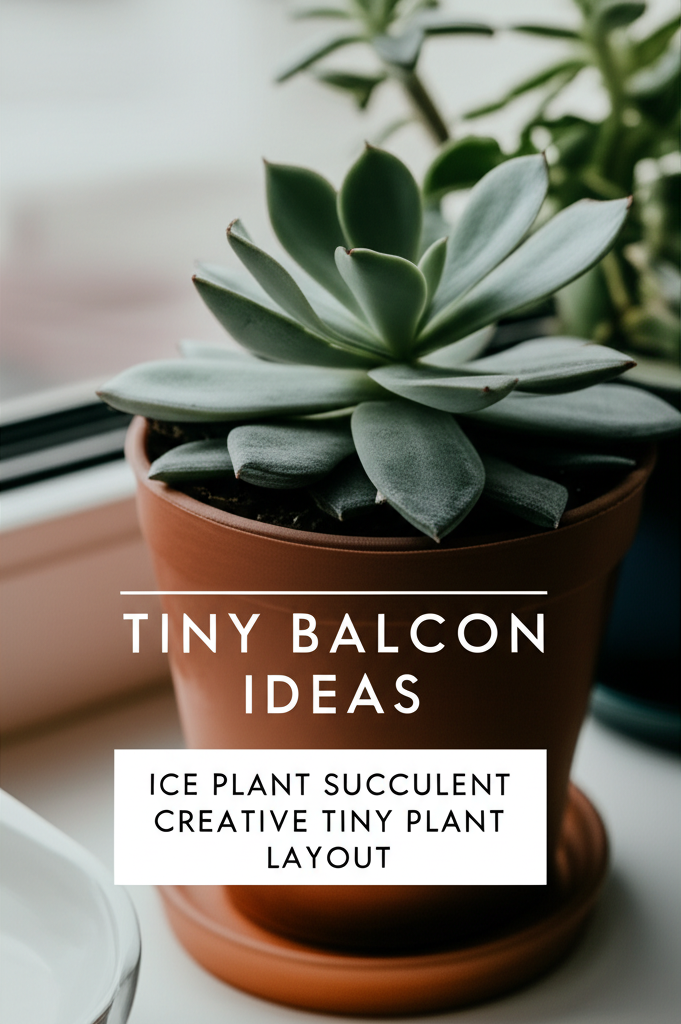Introduction: The Allure of Ice Plants on the Balcony
Tiny balconies, often overlooked urban spaces, hold immense potential for transforming into vibrant green sanctuaries. For those seeking low-maintenance, visually striking, and drought-tolerant greenery, ice plants (family Aizoaceae, subfamily Mesembryanthemoideae) are an exceptional choice. These fascinating succulents, known for their sparkling epidermal cells that resemble ice crystals, offer a unique aesthetic and a surprisingly resilient nature, making them ideal for the challenging microclimates often found on balconies. This article will delve into the creative possibilities of incorporating ice plants into tiny balcony layouts, providing practical advice, design inspiration, and essential care tips to help you cultivate your own miniature desert oasis.
Understanding Ice Plants: More Than Just Pretty Crystals

Before diving into layout ideas, it’s crucial to understand what makes ice plants so suitable for balcony gardening. These plants are native to arid regions, primarily South Africa, and have evolved remarkable adaptations to survive with minimal water and intense sunlight.
Key Characteristics of Ice Plants for Balcony Cultivation:
- Drought Tolerance: Their fleshy leaves store water, allowing them to withstand prolonged dry periods. This is a significant advantage for balcony gardeners who may forget to water or experience heat waves.
- Sunlight Requirements: Most ice plants thrive in full sun, making them perfect for sun-drenched balconies. However, some varieties can tolerate partial shade.
- Low Maintenance: They generally require minimal pruning and are not prone to many pests or diseases.
- Variety in Form and Color: Ice plants offer a stunning diversity in growth habits (trailing, mounding, upright) and flower colors (vibrant pinks, oranges, yellows, whites, and reds). This allows for a rich tapestry of textures and hues on a small scale.
- Hardiness: While many ice plants are tender perennials, some can tolerate light frost, extending their usability in cooler climates when protected.
Key Facts and Comparison of Popular Ice Plant Varieties for Balconies
Selecting the right ice plant varieties is key to a successful and aesthetically pleasing balcony design. Here’s a look at some popular choices, highlighting their suitability for container gardening and small spaces.
| Ice Plant Variety | Growth Habit | Flower Color | Sunlight Preference | Water Needs | Balcony Suitability |
|---|---|---|---|---|---|
| Delosperma cooperi (Hardy Ice Plant) | Spreading, mat-forming | Vibrant magenta-pink | Full sun | Low | Excellent for ground cover in containers, cascading over edges. |
| Lampranthus spectabilis (Showy Ice Plant) | Bushy, upright to semi-cascading | Bright purple, pink, orange, yellow | Full sun | Low | Adds vertical interest and bursts of color. |
| Aptenia cordifolia (Heartleaf Ice Plant) | Vigorous trailing, groundcover | Small, yellow to pinkish-purple | Full sun to partial shade | Low to moderate | Ideal for hanging baskets or spilling over planter edges. |
| Mesembryanthemum crystallinum (Common Ice Plant) | Low-growing, spreading | Small, white to pink | Full sun | Low | Good for filling in spaces and adding texture. |
| Drosanthemum speciosum (Pink Dewflower) | Bushy, upright | Bright pink | Full sun | Low | Compact growth habit, suitable for smaller pots. |
Creative Layout Strategies for Tiny Balconies
Maximizing a small balcony space requires thoughtful planning and creative container placement. Ice plants, with their diverse growth habits, offer a wealth of possibilities.
Elevated Displays and Vertical Gardening
Verticality is your best friend on a tiny balcony. Utilize vertical space to create visual interest and maximize planting area.
- Tiered Planters: Stacked or tiered planters are excellent for showcasing multiple ice plant varieties. Place trailing types on lower tiers to cascade down, while mounding varieties can occupy the upper levels.
- Hanging Baskets: Aptenia cordifolia or trailing varieties of Delosperma are perfect for hanging baskets. Position these at varying heights to create a lush, cascading effect.
- Wall-Mounted Planters: Small wall planters can house compact ice plant species, adding greenery to otherwise bare vertical surfaces.
- Trellises with Potted Plants: While ice plants are not typically climbers, a small trellis behind a few upright ice plant pots can add a subtle vertical element and support a lightweight climbing companion plant.
Ground-Level Groupings and Mixed Containers
Even at ground level, strategic arrangement can make a significant impact.
- Mixed Planters: Combine different ice plant species with varying textures and colors in a single large planter. For example, a mounding Lampranthus in the center with trailing Delosperma around the edges creates a dynamic composition.
- Complementary Color Palettes: Group ice plants with similar or contrasting flower colors. A palette of pinks and oranges can create a vibrant sunset effect, while whites and soft yellows offer a more serene atmosphere.
- Texture Play: Mix ice plants with smooth leaves with those that have more pronounced “ice crystals.” This adds tactile and visual depth.
- Container Variety: Use a mix of terracotta pots, concrete planters, and hanging baskets to introduce different textures and styles. Ensure all containers have adequate drainage.
Focusing on Edges and Cascades
Balcony railings and edges are prime real estate for visual appeal.
- Railing Planters: Specially designed railing planters are perfect for holding a row of ice plants. Trailing varieties will spill over the edge, creating a beautiful, overflowing display.
- Window Boxes: If your balcony has a window, window boxes filled with ice plants offer curb appeal and a delightful view from inside.
- Planter Boxes with Overhangs: Place planters with slightly overhanging edges along the balcony perimeter, allowing the ice plants to drape gracefully.
Essential Care for Balcony Ice Plants
While ice plants are low-maintenance, a few key care practices will ensure their health and vibrant bloom on your balcony.
Watering Wisdom
The most common mistake with succulents is overwatering.
- Check Soil Moisture: Water thoroughly only when the soil is completely dry to the touch. Poke your finger about an inch or two into the soil.
- Watering Method: Water the soil directly, avoiding wetting the leaves unnecessarily, which can lead to rot.
- Drainage is Key: Ensure all pots have drainage holes. Standing water will kill ice plants.
- Seasonal Adjustments: Reduce watering significantly during cooler months when the plants are dormant.
Sunlight and Placement
- Maximizing Sunlight: Place your ice plants in the sunniest spot on your balcony, typically south-facing.
- Heat Stress: On extremely hot days, especially in exposed balconies, some ice plants might benefit from a brief afternoon break from intense direct sun, though most are highly tolerant.
- Wind Protection: While resilient, extremely strong winds can damage delicate flowers and foliage. Consider a sheltered corner or using heavier pots if your balcony is very windy.
Soil and Fertilization
- Well-Draining Mix: Use a cactus or succulent potting mix, or create your own by combining regular potting soil with perlite or coarse sand for improved drainage.
- Fertilizing: Ice plants are not heavy feeders. Fertilize sparingly in spring or early summer with a diluted, balanced liquid fertilizer, or a specialized succulent fertilizer. Over-fertilizing can lead to leggy growth and reduced flowering.
Pruning and Deadheading
- Deadheading: Remove spent flowers to encourage more blooms and keep the plant looking tidy.
- Pruning: Trim leggy or overgrown stems to maintain a compact shape and encourage bushier growth. This can be done after flowering. Propagating from cuttings is easy.
Pros and Cons of Ice Plants on Tiny Balconies
Like any plant, ice plants have their advantages and disadvantages when grown in a containerized balcony environment.
| Pros | Cons |
|---|---|
| Exceptional drought tolerance, forgiving of neglect. | Can be susceptible to overwatering if drainage is poor. |
| Thrive in full sun, ideal for sunny balconies. | Some varieties may not tolerate prolonged periods of heavy rain or frost without protection. |
| Low maintenance, requiring minimal pruning and fertilization. | Can become leggy if not pruned or if they don’t receive enough light (though this is rare for most varieties). |
| Wide variety of colors and growth habits for diverse design options. | Vigorous trailing types might need occasional trimming to prevent them from becoming too unruly. |
| Visually striking with unique “ice crystal” epidermal cells. | May not be as cold-hardy as some other succulents in very harsh winter climates without protection. |
| Attract pollinators like bees and butterflies with their vibrant blooms. | The delicate “ice crystals” can be rubbed off if handled roughly. |
Beyond the Basics: Enhancing Your Ice Plant Balcony Design
Once your ice plants are established, consider these additions to elevate your tiny balcony oasis.
Companion Planting
While ice plants are self-sufficient, pairing them with other drought-tolerant and sun-loving plants can create a more layered and visually complex display.
- Other Succulents: Sedums, Echeverias, and Sempervivums (Hens and Chicks) are excellent companions, offering different leaf shapes and textures.
- Herbs: Rosemary, thyme, and lavender are drought-tolerant herbs that also thrive in sun and can add fragrance to your balcony.
- Ornamental Grasses: Small varieties of ornamental grasses can provide a contrasting texture and movement.
Decorative Elements
Accessorize your ice plant display to further enhance the desert aesthetic.
- Pebbles and Gravel: Top dressing your pots with small pebbles, gravel, or decorative stones not only looks authentic to a desert theme but also helps with moisture retention in the soil surface and prevents soil splash.
- Driftwood or Rocks: A piece of driftwood or a few interesting rocks can add natural sculptural elements.
- Garden Sculptures: Small, minimalist garden sculptures that complement the desert theme can add a touch of artistry.
Conclusion: Your Tiny Balcony, A Thriving Succulent Haven
Transforming a small balcony into a vibrant haven of ice plant succulents is an achievable and rewarding endeavor. By understanding their unique needs and embracing creative layout strategies, you can cultivate a miniature desert oasis that thrives with minimal fuss. From cascading tendrils to bursts of vibrant color, ice plants offer a stunning and resilient solution for urban gardeners. Experiment with different varieties, embrace verticality, and pay attention to the simple care requirements, and your tiny balcony will soon be a shimmering testament to the beauty and resilience of these captivating desert blooms. Enjoy the sunshine, the color, and the low-maintenance joy that your ice plant sanctuary brings.


